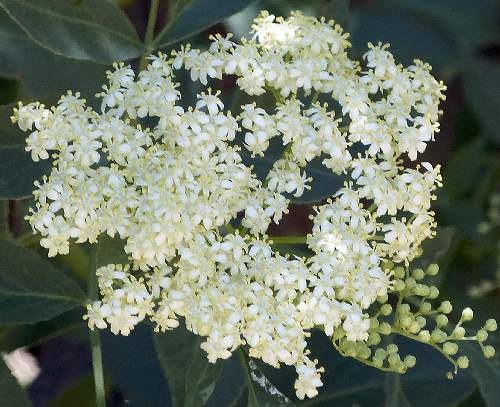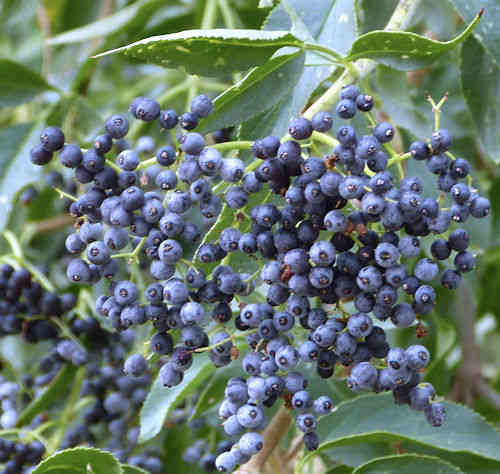Growing Blue Elderberry:
Sambucus cerulea
Back to Fruit, Berries and Nuts
Botanical Overview
Members of the Viburnum family (Viburnaceae), Sambucus species are native to the northern hemisphere. Sambucus nigra, Black Elderberry, is found in Europe and Western Asia. Sambucus cerulea, Blue Elderberry, is found in Western North America from Canada into Mexico. Sambucus canadensis, American Black Elderberry, is native to North America. Sambucus mexicana, Mexican Elderberry, is native to some western states and Mexico. Blue, American Black, and Mexican Elderberry overlap ranges in the West. Sambucus racemosa, Red Elderberry, is found in limited pockets in the Western United States and Canada.
Description
Form:
A multi-stemmed, suckering, large shrub or small tree.
Lifespan:
Possibly 60 years.
Leaf retention:
Drought and cold deciduous.
Growth rate:
Moderate to rapid.
Mature Size:
6-16' (1.8-5m) high and 8-20' (2.4-6m) wide.
Flowers:
Fragrant, yellow to white, tiny, in clusters.
Bloom:
Two months or more starting in late winter or spring, then again in late summer and fall.
Self-fruitful:
Possible but rare. A second plant will be needed within 50' (15.24m) to provide cross
pollination.
Years before fruiting:
2-3.
Fruit:
Blue-black or purple berries, 1/8-1/4" (0.32-0.64cm) in diameter depending on water,
are edible when ripe.
Berries of other species must be cooked to be edible.
Months for fruit to ripen:
5-15 days. The berries are ripe when they are fully dark with a whitish coating.
Storage after harvest:
Place in a sealed container without washing and store in a refrigerator up to 5 days,
or wash and freeze, or wash and prepare for wine or to cook.
Leaves:
Dark green, lance-shaped, sawtooth edged leaflets.
Stems:
No thorns.
Roots:
A deep taproot with an extensive root mass that produces new suckers (canes) yearly which
aid in fruit production.
Cultivars of Note:
There are no named cultivars of Sambucus cerulea, Blue Elderberry, as of this date.
Sambucus cerulea var. neomexicana is a recognized wild variety.
Wildlife:
The flowers attract bees and pollinating insects. The berries attract birds and small mammals.
The plant can be a nesting site for hummingbirds. New growth and young plants are browsed by
deer.
Toxic / Danger: All parts are poisonous except ripe,
blue to purple berries and cooked flowers. Green berries are poisonous. Red berries of Red
Elderberry and other species are poisonous if eaten raw but are edible when cooked.
Origin:
North America.
Cultivation and Uses
USDA hardiness zones:
4-10 for Blue Elderberry, 4-8 for American Black Elderberry.
Chill hours:
Very low, possibly 100-300.
Heat tolerant:
Yes.
Drought tolerant:
Yes, but loses leaves and fruit.
Sun:
Full sun to part shade.
Planting:
Place rooted cuttings and seedlings, that are at least one year old, in full sun in well
draining soil. Space the plants at least 15' (4.5m) apart.
Soil:
This plant is tolerant of soil types with a pH range of 6.1-7.8 (slightly acidic to slightly
alkaline). It survives in soil that is well-draining with low organic content, but the best
fruit production occurs in enriched, slightly acidic soil.
Fertilize:
Use composted manure for rapid growth.
Water once established:
Deep water once or twice a week when flowering and
fruiting. Signs of insufficient water are dropped fruit, dropped leaves, and flowers that do
not develop fruit. No berries are produced without sufficient water. Deep water once a month
when not flowering or fruiting.
Mulch:
Unnecessary.
First Year Care:
New seedlings and cuttings must stay in pots with moist soil in all day part shade until they
are one year old.
Prune:
In late winter, during dormancy, remove dead, weak and broken canes, as well as all canes
older than 3 years. Flowers and fruit develop on tips of new growth, especially on laterals
of previous year's canes. After three years, canes produce few flowers.
Litter:
Low.
Propagation:
Semi-hardwood cuttings with at least 2 nodes are taken during bloom, making an angled cut at
the bottom, treated with naphthalene acetic acid (NAA) formulation (rooting hormone), planted
in a pot with potting mix, and watered. The pot is planted in the ground outside in a shady
location and tented with a plastic bag to keep the mix moist. Rooting success is over 60%
with this method for this species. Transplant carefully once roots develop because the young
roots are fragile.
Seed should be cold stratified for 4 months, then planted in a cool, shady location. Seed does not grow true to the parents.
Seed should be cold stratified for 4 months, then planted in a cool, shady location. Seed does not grow true to the parents.
Uses:
Ornamental, edible berries for jams, jellies, syrup and wine. Blue and purple berries can
be eaten raw. The flowers become edible when cooked, or fried like fritters, or used to make
tea or wine
Comments
Elderberry was formerly classified as a member of the Honeysuckle family.
Adoxaceae is a family synonym.
Sambucus cerulea was formerly known as Sambucus caerulea, Sambucus nigra ssp. cerulea,
and Sambucus mexicana which is now a separate recognized species.
Blue Elderberry grows wild in the southwestern mountain regions of the United
States, and is sometimes grown as an ornamental shrub in its native region.
Do you have additional information or a different experience for these plants that you would like to share? Email info@GardenOracle.com. All contributions are welcome and appreciated.
Do you have additional information or a different experience for these plants that you would like to share? Email info@GardenOracle.com. All contributions are welcome and appreciated.




Latest update: July, 2024
© 2008-2025 by GardenOracle.com

